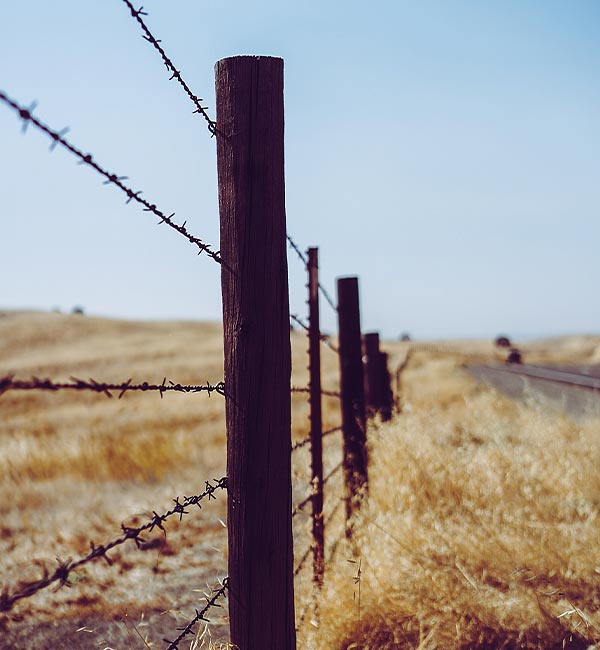Subtotal: $
Checkout
How to Build a Fence
I had preached about the value of handwork, but when my neighbor showed up with that big shiny green tractor, I capitulated.
By Jonathan Kirk Brooks
March 19, 2022
In June 2020, Jonathan Kirk Brooks wrote for Plough about his decision to leave behind a career as a school principal to carve out a life on the land working alongside his wife and children. Here he reports back about a day on the farm.
I was fencing for the first time in my life. We wanted sheep, and we needed a place to keep them. We had already set thirty posts by hand in two afternoons. We’d pulled some fence each day, using the old Massey Ferguson 35 – a tractor I inherited from “Paps,” my grandfather, who bought it new around 1961. Stretching a long pull of woven wire fence after several posts were in the ground offered a much appreciated break from tamping posts for me and anyone else I had roped into coming over for a day of “fun” farm work.
There were about five of us that day, and we were tired. I like to exercise a little, but there’s no workout I’ve found quite like tamping fence posts. This particular June day, I had managed to conscript some pretty good help: a friend from church, a neighbor, and a couple former students of mine – young men with healthy muscles and good backs eager for a rare opportunity for hard, physical, outdoor work. Relegated to flipping greasy burgers at a fast food joint, they had asked to come and help with something, anything, else instead. Here was their chance (and mine) to put all that teenage eagerness, energy, and muscle to good use. Their parents were happy to loan them to me, and I was happy to see them.
I had spent the better part of a year watching YouTube videos, talking to farmers willing to share what they knew, and helping some of them build fences in their own pastures – by far the most valuable piece of my education. I made lists of the tools and supplies I would need. I made notes about which staples I preferred to work with, how long I’d want them to be, what kind would last the longest, where to buy (or cut my own) fence posts, what type of trees made the best posts, how to drive staples into the impossibly tough Osage orange tree if you had to, how deep (and wide) to dig post holes, how far apart to set the posts, which fencing pliers were preferred. And all of this doesn’t even begin to touch on the necessary education required for building fence braces! If all of that were an undergraduate course at a university, fence-bracing would be a graduate level course – and far more practical than the majority of the graduate level courses I took to become a middle-school principal.

Photograph by Daniel Salgado
For the help I offered neighbors during my fencing education, I had been paid in knowledge, new friendships, and various used tools and supplies. “Red” Shryock gave me some big corner posts and a roll of perfectly good used fence he had been keeping in a barn of his. Ford Roberts gave me more fence posts and a ton of his time and knowledge. I got an old metal gate from Doug Ball. Simon Peters let me borrow a PTO-driven post hole auger that fit our old tractor. Tony Jury got me started with his own help and know-how and let me borrow a fine old fence stretcher and a come-along. And Randy Bishop came by with another tractor and tools and knowledge to help speed things up a little (more on “speeding up” in a minute). There was more gift and grace and help than I can remember in full. From my time with these men and others, I learned much, but one thing repeated itself on a regular basis: building fences is an art. I decided that if I could do it well, a good fence should not only keep my animals in and predators out; it should also be a pleasure to look at for years to come. But as one old farmer friend whom I respect very much told me, the last fence I built would be better than my first one. At some point one has to quit studying a thing and begin it. So I did.
It was the third day of drilling and digging and setting and leveling and tamping and pulling – and doing it all again, over and over until you knew the only thing that would taste better than dinner that night would be dinner the next night, and so on until the work was finished. My wife, Meghan, had turned her attention to the work of feeding us all each day: there were biscuits and gravy, eggs from our hens, soup and corn bread, all made from scratch and all of it so dangerously satisfying that my helpers might have fallen asleep after lunch if I had let them. There was plenty of talk and laughter, too, all of us happy to be in out of the sun and sitting down for a change.
That afternoon I got a call from a friend who heard we’d been at work all morning and told me he had gotten loose from some of his own work and was offering to come by with a big tractor (bigger and newer than our little Massey Ferguson) and a fence-post driver.
There is a quicker way to set fence posts.
If you’re willing to spend the money, you can purchase a fence-post driver and a tractor that will operate it (most medium-to-large tractors will). A fence-post driver mounts on the back of a tractor. It has a large anvil-type weight at the top that is usually raised and lowered hydraulically. One man can position the post up against the machine, as straight up and down as possible, while another man sits on the tractor and operates the post driver. The weight on the post driver is raised and then quickly dropped on the top of the post again and again, hammering it into the ground and saving a lot of time on digging and tamping. I had never used a fence-post driver before, but here, in my time of need and exhaustion, was a friend offering to help finish up our last four hours of work in an hour or less thanks to this marvel of industrial machinery.
I was tired. I had grown weary of setting fence posts by hand. So when that big shiny green tractor came by in all its industrial revolutionary diesel glory, I capitulated.
I pushed out of my mind all the essays I had written and read – and all the sermons I had preached to my wife and children – about the value of hand-work and avoiding the noise and stink of machines and working together with neighbors and going slow to make something beautiful instead of going quickly to get it done. It was getting on to be dinnertime after all. I was tired. I had grown weary of setting fence posts by hand. So when that big shiny green tractor came by in all its industrial revolutionary diesel glory, I capitulated.
“Whoa!” I heard someone yell over the mechanical pounding and roar of that big diesel John Deere. We had already set five posts in the time it had taken me to set one earlier in the day. But just now there had been a small explosion. I had instinctively jumped back, or fallen back, and was now sitting on the ground, feeling my face with both hands. It was peppered with large splinters. My face was radiating, like a bad sunburn. My eyes were watering but I didn’t know it until I took my hands away from my face and realized they were wet. My face was numb. The other men standing close by were all right, and I was too after just a few minutes.
Randy called from the tractor, “You all right, Brooks?”
“I’m all right. You just about knocked my derned head off with this contraption though!”
“Well, if you weren’t such a cheapskate and wouldn’t have bought these damned used posts that wouldn’t have happened!”
I knew he was right. I had tried to save money and time. I had bought used fence posts. Frugality is a virtue, I told myself. And there would have been no problem using them; they would have lasted a good many years. It was only when I turned to bigger technology to speed things along that the trouble began. The fence posts I had chosen were in fact, fine – to be set by hand, not, I learned, by a tractor.
What was it Jesus said about the hypocrite with a plank in his own eye? Or was it a fence post?
“I don’t know, Randy,” I stammered, standing up, my hands still feeling my face, half expecting to find a large piece of wooden shrapnel sticking out of it, “I’m thinking I should’ve hired a different driver.”
“Well, you get what you pay for!” he said.
And we laughed.
Randy, like the other men that day, was volunteering his time. For free. For kindness. For neighborliness. He was participating in the dying art of neighborhood work. He was a loving participant in the communal art of building fences. He was a good man, and he had built a good many more fences than I probably ever will. The quality of the fences mattered to him, too, and he was right – these old posts couldn’t take the beating this post driver was giving them. We had three left. We went on working as we had been, this time turning our heads away from the post each time the machine hit the top of it – that jarring, obnoxious, mechanical pounding. There were, thankfully, no more surprises.
Already a subscriber? Sign in
Try 3 months of unlimited access. Start your FREE TRIAL today. Cancel anytime.







Steve Hawkins
As a career teacher who also did ranch work for about 14 years during summers, I can relate to your article. I really liked what you said about a fence not only keeping animals in (or out) but also that is would look good for years to come. There is something particularly satisfying about building a straight, solid fence. Besides the hard physical labor, there is an art and craft to it that can only be appreciated by those who have done it. Although there is something to be said for a good tractor-driven post hole auger for helping set H-braces.
Susan
Your article makes me think about the struggle it is for all of us to slow down and choose gentler ways, but I admire the effort you’re making. Well written and thought-provoking.